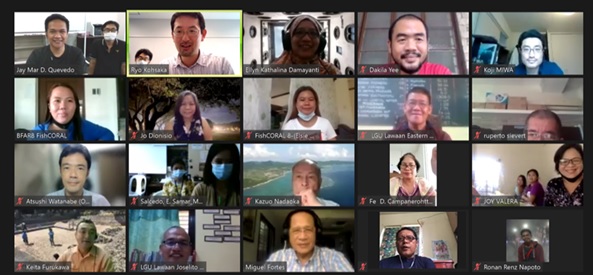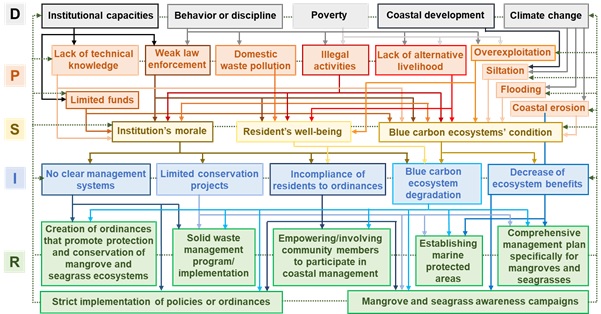The blue carbon concept recognizes the vital role of mangrove forests, seagrass meadows, and salt marshes (collectively referred to as blue carbon ecosystems, or BCEs) in mitigating climate change through carbon sequestration while delivering other essential benefits such as food and livelihood provision, coastal protection, and cultural services [1]. However, despite their diverse ecosystem services, BCEs are continuously subjected to anthropogenic (e.g., land-use conversion) and natural (e.g., typhoons) threats which in turn result in the reduction or loss of their important services. In the climate mitigation context, a large number of carbon stocks sequestered over the years are threatened to be released back into the atmosphere, contributing to further rising of the global temperature, if these ecosystems continue to be degraded or lost [2]. Thus, the blue carbon concept has now reached international prominence and gained attraction from diverse groups of individuals including the scientific community, policymakers, private practitioners, non-government organizations, and intergovernmental bodies committed to address knowledge gaps, to conserve and protect, and to provide science-based recommendations for policy and management strategies of BCEs [3].
Among the international actors, the Asia-Pacific Network for Global Change Research (APN) supports global change research on climate mitigation through collaboration and cooperation from multiple sectors which aimed to enhance capabilities and strengthen interactions, particularly between scientists and policymakers. The APN, which complements and supports the Sustainable Development Goals (SDGs), solidifies the call for an integrative approach in solving global issues such as climate change. Through APN’s support, the project “Enhancing capacities of local stakeholders in Coral Triangle in managing Blue Carbon Ecosystems for climate mitigation and adaptation” (project reference number: CBA2020-05SY-Kohsaka) aims to contribute to BCE management from local perspectives of social and policy sciences which are largely overlooked, yet, integral parts of sustainability. The project envisages a transdisciplinary approach (e.g., involving communities, practitioners and scientists) to empower local communities and sustainably use BCEs. Through a collaborative approach from scientists and national-to-local governmental bodies, with aspirations from SDGs and APN goals, a series of capacity development will be conducted for key stakeholders of BCEs.
As part of the project’s aim to enhance the capacities of stakeholders, a first of a series of workshops was held online on 2 July 2021, where key local policymakers of Eastern Samar province, Philippines, were engaged in blue carbon and climate dialogues. Participants of the workshop were composed of ten scientists, ten municipal-level policymakers, and three provincial-level project implementers. The province was selected as one of the priority sites for capacity development since previous research activities have shown that BCEs are highly perceived by communities for their food and coastal protection benefits [4][5]. However, despite this, BCEs are threatened by anthropogenic and natural forces (e.g., strong typhoons), with the latter as the most pronounced driver. Being geographically located at the eastern Philippine seaboard, the province is frequently visited by typhoons, which in turn affects BCEs and communities. With the increasing effect of climate change, the frequency of severe weather patterns is most likely to become more prominent in the present years. Thus, there is a need to capacitate local stakeholders on sustainable management of BCEs, which are essential in community resilience and climate mitigation and adaptation.

Gearing towards the project’s overall objective, two activities, namely SWOT (Strength-Weakness-Opportunity-Threats) and DPSIR (Driver-Pressure-State-Impact-Response) analyses were conducted as preliminary steps to determine their needs and existing issues and how the project can help in developing and enhancing their capacities. The former was used to identify the existing capacities and capabilities of local policymakers. SWOT analysis is a well-recognized participatory assessment tool in gathering, synthesizing, and analyzing information from, for instance, programs, stakeholders, and services [6]. A pre-workshop meeting was held with the local participants to help them determine the SWOT components. Each element was rated accordingly using a five-point Likert scale—“strengths” and “opportunities” from 1 (fair) to 5 (exceptional) and “weaknesses” and “threats” from 1 (weak) to 5 (critical). Meanwhile, the latter was utilized to understand the cause-effect linkages of threats to BCEs and their corresponding management solutions. The DPSIR framework is a holistic management tool that helped in establishing and organizing complex environmental problems in a way that is meaningful to decision-makers through a causal chain that links science and policies [7]. The activity started with identifying “drivers” leading to “pressures” in the society that would result in changes in its “state”. These forces, in turn, result in certain “impacts”, which warrant the creation of “responses”.
The first activity revealed the existing capacities and capabilities of the local stakeholders and their municipalities. As key policymakers, their strengths included having good communication among different municipal-level agencies (e.g., municipal agriculture office and tourism office) and implementing different local ordinances. Meanwhile, as a municipality, having an organized people’s associations and strong participation of the community in management activities were their strong points. However, management implementations, as shared by the participants, are sometimes limited due to a lack of technical capabilities and financial constraints, coupled with overlapping government regulations and mandates and personal interests among different stakeholders. Thus, they perceived that there is an opportunity to efficiently communicate amongst themselves and effectively implement their mandated tasks. Despite the strong participation of residents in management activities, policymakers identified the lack of motivation to sustain these activities as a critical threat. This is vital information in the context of sustainable management of BCEs. Key policymakers should come up with solutions such as alternative livelihood incentives to encourage residents in continuing their support to management programs.

The second activity engaged local participants in discussing the threats and management issues of BCEs. Using the DPSIR framework, they were able to identify emerging issues that hinder their management actions, influence the public’s behaviour, and affect BCEs. For instance, they shared that limited institutional capacities cause pressures such as lack of technical knowledge, limited funds, and weak law enforcement. These pressures, which influence the institution’s morale, led to limited conservation projects, unclear management protocols, incompliance of residents to ordinances, and, eventually, degradation of BCEs. In response, policymakers perceived to strengthen their implementation of programmes, create suitable BCE management plans, involve communities in coastal management, and increase environmental awareness campaigns. The local participants were also able to identify climate change as a driver that impacts their BCEs. They are cognizant that pressures such as flooding and coastal erosion could result in the decrease of ecosystem benefits. Thus, they envision that a comprehensive management plan specifically for these resources is needed for coastal resilience and climate adaptation.

Both activities allowed open discussions between the local decision-makers and scientists. Involving them to blue carbon and climate discourse warrants a more inclusive approach since they are the ones who experienced first-hand the effect of climate change, such as the frequency of more intensified typhoons and benefiting from BCEs. Despite time constraints and limited activities, the project gathered preliminary information that is vital in selecting priority areas for capacity development. Understanding how policymakers function, their motivation and challenges, and existing capabilities and capacities is a necessary step in order to effectively enhance or develop new management strategies in line with BCEs and climate mitigation and adaptation.
References:
- [1] Nellemann, C., Corcoran, E., Duarte, C. M., Valdrés, L., Young, C. D., Fonseca, L., & Grimsditch, G. (2009). Blue carbon: The role of healthy oceans in binding carbon. Retrieved from https://portals.iucn.org/library/node/9442
- [2] Duarte, C. M., Losada, I. J., Hendriks, I. E., Mazarrasa, I., & Marbà, N. (2013). The role of coastal plant communities for climate change mitigation and adaptation. Nature Climate Change, 3, pp. 961-968. doi:10.1038/nclimate1970
- [3] Macreadie, P. I., Anton, A., Raven, J. A., Beaumont, N., Connolly, R. M., Friess, D. A., … & Duarte, C. M. (2019). The future of Blue Carbon science. Nature Communications, 10(1), 1-13. doi:10.1038/s41467-019-11693-w
- [4] Quevedo, J. M. D., Uchiyama, Y., & Kohsaka, R. (2020). Perceptions of local communities on Mangrove forests, their services and management: implications for eco-DRR and blue carbon management for Eastern Samar, Philippines. Journal of Forest Research, 25 (1), 1-11. doi:10.1080/13416979.2019.1696441
- [5] Quevedo, J. M. D., Uchiyama, Y., & Kohsaka, R. (2020). Perceptions of the seagrass ecosystems for the local communities of Eastern Samar, Philippines: preliminary results and prospects of blue carbon services. Ocean and Coastal Management, 191, 105181. doi:10.1016/j.ocecoaman.2020.105181
- [6] Suh, J., & Emtage, N. F. (2005). Identification of strengths, weaknesses, opportunities and threats of the community-based forest management program. Annals of Tropical Research, 27 (1), 55-66.
- [7] Kohsaka, R., 2010. Developing biodiversity indicators for cities: applying the DPSIR model to Nagoya and integrating social and ecological aspects. Ecological Research, 25 (5), 925-936. doi:10.1007/s11284-010-0746-7


